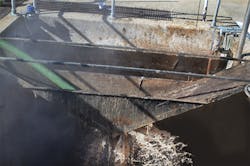Advanced Level, Flow Control Technology Plays Integral Role in WWTP Grease-to-Gas Project
By Mark Mackinnon
Turning a waste product into a useful commodity is one of the seminal achievements of the Green Revolution. There’s no better example of this than the modern day “bioalchemy” that transforms waste grease into prime biogas that can fuel heating, dehumidification and power generation units at wastewater treatment plants (WWTPs).
In fact, a sanitary district in northeastern Illinois has undertaken just such a green initiative and is turning common forms of waste grease into a biofuel that boosts self-sufficiency for the plant’s heat and electricity needs. Methane gas captured for process heating and dehumidification has already saved the plant over $115,000 in natural gas costs annually. An upgrade to be completed this year will boost digester methane production and use the gas to generate electricity to further save the plant an estimated $100,000 per year.
Approximately three billion gallons of waste greases are produced by restaurants and institutions every year in the U.S., according to the EPA’s Office of Solid Waste. These massive amounts of fats, oils, and greases (FOGs) have traditionally ended up in landfills or have been poured down drains to coat and clog sewers and contaminate the environment. Disposing of grease has become increasingly more challenging, as many landfills no longer accept it. Those that do often levy a hefty dumping surcharge.
Through a process called codigestion, however, the Illinois-based sanitary district is increasing its methane gas production in five anaerobic digesters by using waste grease collected from regional waste haulers and offloaded at its facility’s grease receiving station. Fed into digester feedwater, the grease is converted into biogas for fueling generators to make electricity. Anaerobic digestion naturally produces methane gas as it breaks down organic matter, but when waste grease is added it not only accelerates the digestion process but produces more methane of a higher quality. Adding grease wastewater to the anaerobic digestion process typically increases methane gas concentration and raises the average BTU value of the methane from 500 to approximately 625. Harvesting this high-grade methane for electric power is an innovative way to offset a facility’s power needs.
The waste-to-gas process reduces energy and maintenance costs and provides security from interruptions in the natural gas and electricity grids. Diverting FOGs into biofuel before they seep into sewers further conserves resources - about 80 percent of the sanitary sewer overflow events in the U.S. result from FOGs clogging municipal sewer pipes. Commercial haulers offloading grease can also create revenue for WWTPs from “tipping fees.”
According to the Northwest Biosolids Management Association (NBMA), approximately 15,000 WWTPs operate anaerobic digesters across the United States but only one-third puts their biogas to work - and even fewer use it to produce electricity. That puts this sanitary district ahead of the curve.
Although the plant’s original digesters were performing well and producing energy for process heating, management wanted still more efficiency from the treatment system. With the average WWTP consuming more electricity than any other municipal service - sometimes as much as 30 to 40 percent of overall energy consumption - it’s not surprising that this facility has moved steadily toward increasing self-sufficiency in energy generation. The electrical generation unit that now boosts production of digester gas, purifies it, and converts it into electricity was made possible in part by state environmental and economic opportunity agency grant initiatives.
Because of its long-standing relationship with the sanitary district, Magnetrol International was called in to address the level and flow needs for the new waste-to-gas system. The first application to be addressed was the grease receiving station at the project’s front end, a 12-foot-deep, in-ground cement repository where waste haulers offload their grease. The level measurement application was somewhat challenging because warm grease dumped during colder months can create steam that the level device must cut through in order to make accurate measurements. It was precisely for its ability to detect true level despite the compromised atmosphere that the non-contact Echotel® Model 355 ultrasonic level transmitter was selected for the grease receiving station. Each of the five floating roof digesters also utilize a pair of Model 355 ultrasonic transmitters.
At the back end of this multi-million-dollar project, three Thermatel® TA2 thermal mass flow meters monitor methane gas flow from the digesters. Initially, plant personnel did not know how much methane would be produced with any degree of certainty. Knowing the exact amount of methane was necessary in order to select the generator with the right capacity for the job. The TA2 flow meters compiled the required data and the generator was specified.
As a result of the waste-to-gas initiative, the forward-thinking sanitary district anticipates the ability to generate 50 percent of its electricity from biogas.
About the Author: Mark Mackinnon is a product support specialist for Magnetrol International.


